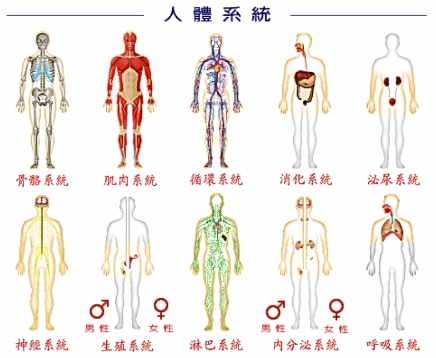|
When
a collection of organs that work together to perform specific tasks, they
form a body system. The human body can
be distinguished into 10 systems, and each of them is essential for life. |
|
當一些器官結集起來共同執行某些特殊任務的時候,就構成了人體的系統。人體可分為十個系統,各系統對維持生命都起著一定的作用。
|
|
The
skeletal system consists of 206
bones. Its functions include: |
|
骨骼系統由 206 塊骨頭組成。其功用包括:
|
 |
Strengthen
and support the body. |
|
|
 |
強化及支撐身體。
|
|
 |
Protect
important internal organs. |
|
|
 |
保護體內重要器官。
|
|
 |
Provide
attachments and levers for muscular contractions. |
|
|
 |
在運動中為肌肉提供附著點和槓桿。
|
|
 |
Produce
blood cells. |
|
|
 |
製造血球。
|
|
 |
Site
to storage and liberate minerals (e.g., calcium, phosphate, etc.). |
|
|
 |
礦物質(如鈣、磷等)儲存及釋放的場所。
|
|
|
The
muscular system contains three
different kinds of muscle, which vary in shapes and functions. |
|
肌肉系統由三種不同形態和功能的肌肉組成。
|
 |
Skeletal
muscles are attached to the skeleton, and can be moved
according to the mind (i.e., voluntary). |
|
|
 |
骨骼肌附著在骨骼上,能夠隨著意志活動。
|
|
 |
Smooth
muscles is found on the wall of hollow organs inside the
body, and cannot be controlled by the mind (i.e., involuntary). |
|
|
 |
平滑肌構成體內器官的內層,不受意志操縱。
|
|
 |
Cardiac
muscles can only be found in the heart. Its strong and
powerful contractions are also involuntary. |
|
|
 |
心臟肌只能在心臟找到,其強而有力的運動也是不受意志的控制。
|
|
|
Functions
of the muscular system include: |
|
肌肉系統的功用包括:
|
 |
Constitute
different kinds of body movements through muscular contractions
(e.g. heart beat and breathing). |
|
|
 |
藉著肌肉收縮構成人體的各種活動(包括心跳和呼吸)。
|
|
 |
Maintain
posture, stabilize joints, and produce energy. |
|
|
 |
保持姿勢、固定關節及產生能量。
|
|
|
The
nervous system is composed of the
brain, spinal cord, and millions of nerve cells (i.e., neurons),
which constitute a huge and complicated network. The major function of the
nervous system is to pass information and nerve impulses from one part of
the body to another. |
|
神經系統由腦部、脊髓和數以百萬計的神經細胞(神經元)組成,並且構成了一個龐大而複雜的網絡。神經系統的主要功用是把訊息及神經衝動從身體的某處傳送至另一處。
|
|
The
respiratory system consists of the
lungs and the many air tracts of different sizes. Cells and tissues inside
the human body must be continuously supplied with oxygen to produce energy
for survival. The main function of the respiratory system is to provide
passages and room for gaseous exchange. |
|
呼吸系統由肺及各大小不同的氣管組成。人體內的細胞和組織,必須不斷有氧氣的補給才能夠產生能量和生存。呼吸系統的主要功用是提供空氣到肺的通路及氣體交換的場所。
|
|
The
circulatory system is composed of the
heart and a complicated network of blood vessels. Its main function is to
transport nutrients and oxygen to the body tissues, and remove metabolic
wastes from the cells at the same time. |
|
循環系統由心臟和複雜的血管網絡構成,其主要功用是負責把養分和氧氣輸送至體內各組織,並同時把代謝後的廢物從細胞帶走。
|
|
The
lymphatic system is made up of a
network of lymph vessels that runs along the veins and arteries. It is a
system to drain excess fluid from the spaces between cells. Functions of
the lymphatic system include: |
|
淋巴系統是由一組與靜脈及動脈平行的盲管所組成的網絡,是一套排除細胞間多餘體液的系統。淋巴系統的功用包括:
|
 |
Drain
excess fluid from the spaces between cells (i.e., lymph) back to the
bloodstream. |
|
|
 |
把滯留在組織間多餘的體液(淋巴液)送回血流。
|
|
 |
The
lymph node along the lymph vessels contains cells that can destroy
bacteria, and helps the immune response. |
|
|
 |
淋巴管的淋巴結有細胞可清除細菌,及幫助免疫反應。
|
|
|
The
digestive system contains the
esophagus and certain organs responsible for digestion (e.g., stomach,
intestines, liver, and gall bladder). It main function is to break down
food into smaller substances for better absorption. |
|
消化系統由食道和一些負責消化的器官,如胃、腸、肝、膽等組成,其主要功用是把食物分解成較細小及容易被吸收的物質。
|
|
The
urinary system is made up of two
horsebean-shaped kidneys, two ureters, urinary bladder, and the urethra.
Major functions of the urinary system include: |
|
泌尿系統由兩個蠶豆形的腎臟、輸尿管、膀胱和尿道組成。泌尿系統的主要功用包括:
|
 |
Discharge
metabolic wastes outside the body through urination. |
|
|
 |
把代謝的廢物從尿液排出體外。
|
|
 |
Maintain
internal balance of water and salt . |
|
|
 |
維持體內水及鹽分的平衡。
|
|
 |
Adjust
pH of blood. |
|
|
 |
調節血液的酸鹼平衡。
|
|
|
The
endocrine system is made up of special
glands called the endocrine glands. Its major functions is to secrete
hormones to regulate metabolism of the body, growth, development and
reproduction. |
|
內分泌系統由一些稱作內分泌腺的特別腺體組成,其主要功用是分泌激素以調節身體代謝、生長、發育與生殖。
|
|
The
reproductive system differs very much
in male and female. The major function of the reproductive system is
for the production of offspring. |
|
男性與女性生殖系統的構造有極大的分別。生殖系統的主要功用就是繁殖後代。
|


